The Cambridge History of Japan, Vol. 3: Medieval Japan
Подождите немного. Документ загружается.

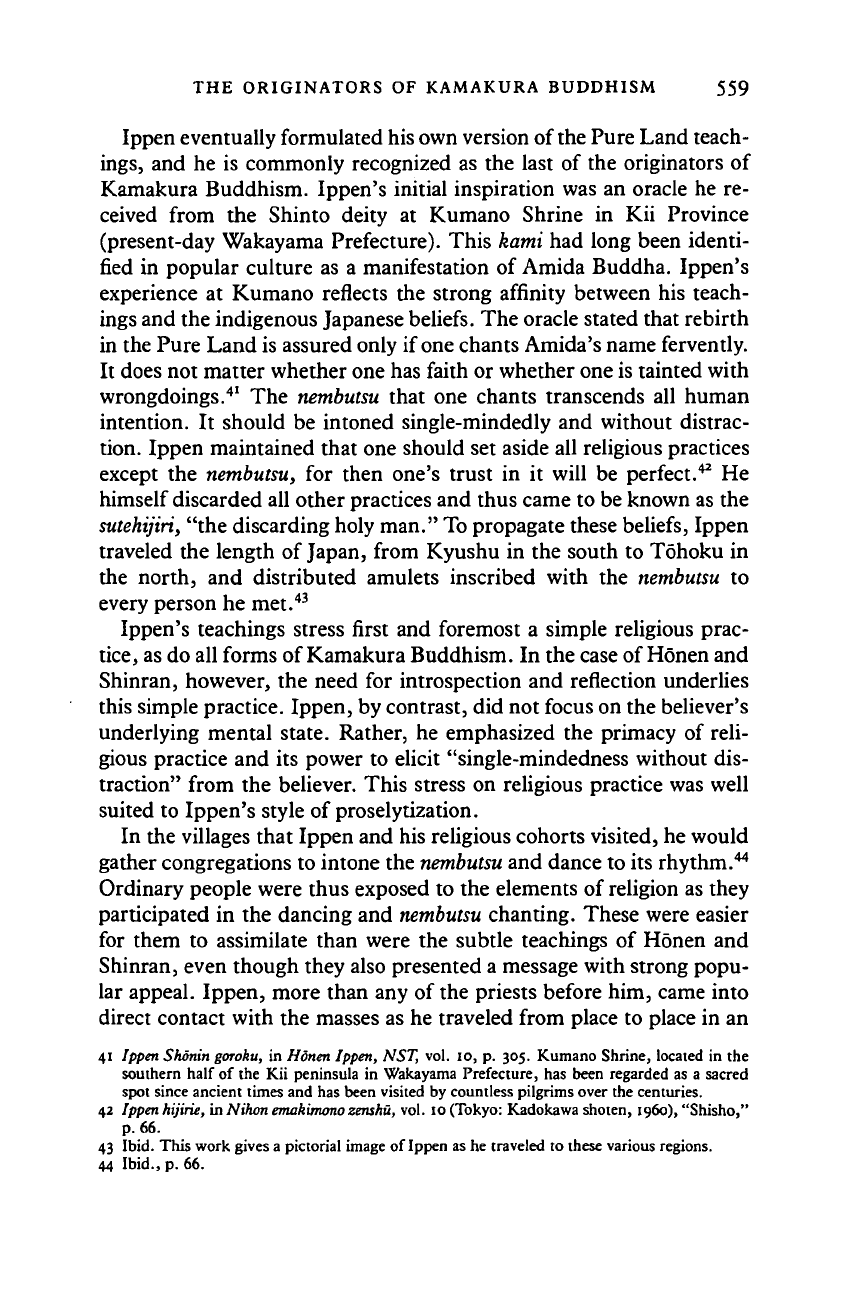
THE ORIGINATORS OF KAMAKURA BUDDHISM 559
Ippen eventually formulated his own version of the Pure Land teach-
ings,
and he is commonly recognized as the last of the originators of
Kamakura Buddhism. Ippen's initial inspiration was an oracle he re-
ceived from the Shinto deity at Kumano Shrine in Kii Province
(present-day Wakayama Prefecture). This kami had long been identi-
fied in popular culture as a manifestation of Amida Buddha. Ippen's
experience at Kumano reflects the strong affinity between his teach-
ings and the indigenous Japanese beliefs. The oracle stated that rebirth
in the Pure Land is assured only if one chants Amida's name fervently.
It does not matter whether one has faith or whether one is tainted with
wrongdoings.
41
The
nembutsu
that one chants transcends all human
intention. It should be intoned single-mindedly and without distrac-
tion. Ippen maintained that one should set aside all religious practices
except the
nembutsu,
for then one's trust in it will be perfect.
42
He
himself discarded all other practices and thus came to be known as the
sutehijiri,
"the discarding holy man." To propagate these beliefs, Ippen
traveled the length of Japan, from Kyushu in the south to Tohoku in
the north, and distributed amulets inscribed with the
nembutsu
to
every person he met.
43
Ippen's teachings stress first and foremost a simple religious prac-
tice,
as do all forms of Kamakura Buddhism. In the case of Honen and
Shinran, however, the need for introspection and reflection underlies
this simple practice. Ippen, by contrast, did not focus on the believer's
underlying mental state. Rather, he emphasized the primacy of reli-
gious practice and its power to elicit "single-mindedness without dis-
traction" from the believer. This stress on religious practice was well
suited to Ippen's style of proselytization.
In the villages that Ippen and his religious cohorts visited, he would
gather congregations to intone the
nembutsu
and dance to its rhythm.
44
Ordinary people were thus exposed to the elements of religion as they
participated in the dancing and
nembutsu
chanting. These were easier
for them to assimilate than were the subtle teachings of Honen and
Shinran, even though they also presented a message with strong popu-
lar appeal. Ippen, more than any of the priests before him, came into
direct contact with the masses as he traveled from place to place in an
41 Ippen Shonin
goroku,
in Honen Ippen, NST, vol. 10, p. 305. Kumano Shrine, located in the
southern half of the Kii peninsula in Wakayama Prefecture, has been regarded as a sacred
spot since ancient times and has been visited by countless pilgrims over the centuries.
42 Ippen hijirie, in Nihon
emakimono
zenshu,
vol. 10 (Tokyo: Kadokawa shoten, i960), "Shisho,"
p.
66.
43 Ibid. This work gives a pictorial image of Ippen as he traveled to these various regions.
44 Ibid., p. 66.
Cambridge Histories Online © Cambridge University Press, 2008
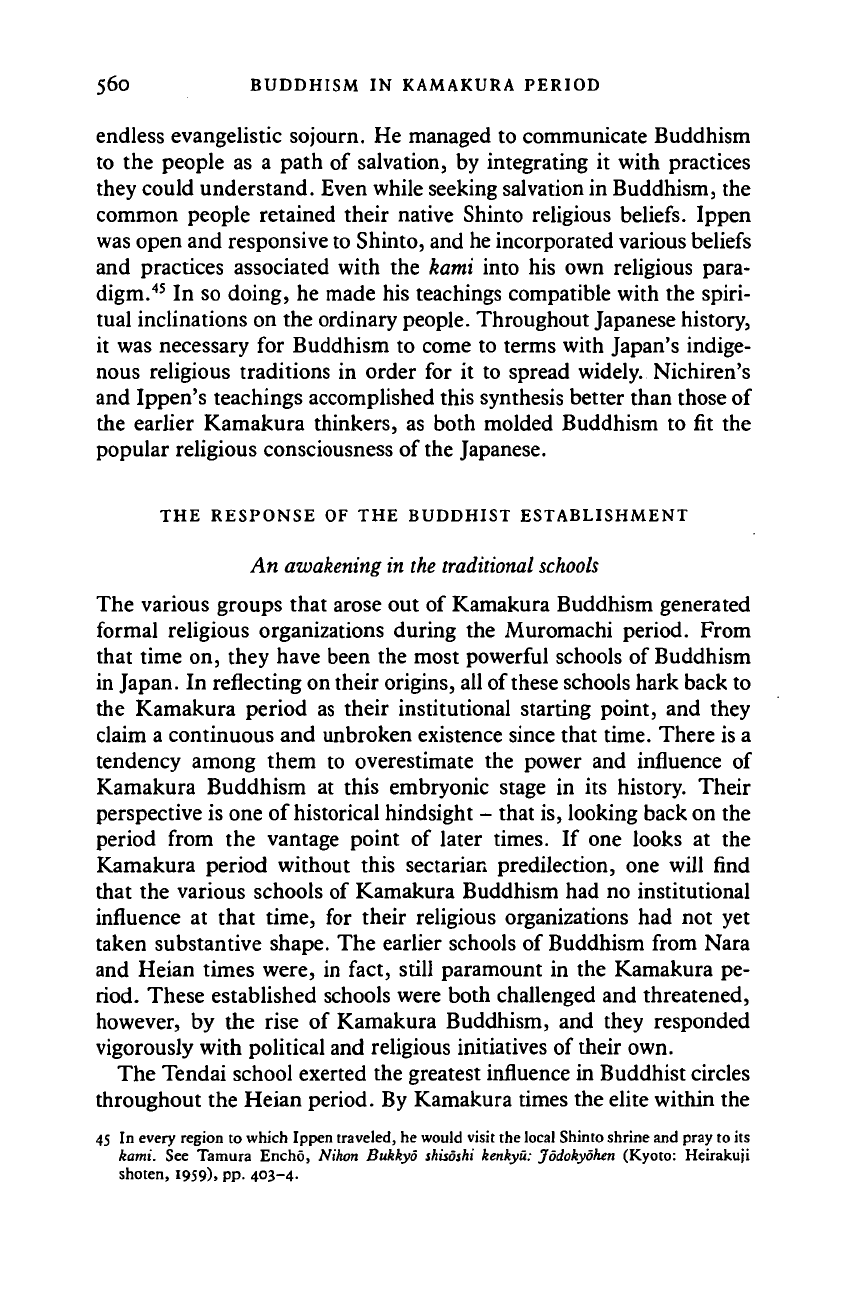
560 BUDDHISM IN KAMAKURA PERIOD
endless evangelistic sojourn. He managed to communicate Buddhism
to the people as a path of salvation, by integrating it with practices
they could understand. Even while seeking salvation in Buddhism, the
common people retained their native Shinto religious beliefs. Ippen
was open and responsive to Shinto, and he incorporated various beliefs
and practices associated with the kami into his own religious para-
digm.
45
In so doing, he made his teachings compatible with the spiri-
tual inclinations on the ordinary people. Throughout Japanese history,
it was necessary for Buddhism to come to terms with Japan's indige-
nous religious traditions in order for it to spread widely. Nichiren's
and Ippen's teachings accomplished this synthesis better than those of
the earlier Kamakura thinkers, as both molded Buddhism to fit the
popular religious consciousness of the Japanese.
THE RESPONSE OF THE BUDDHIST ESTABLISHMENT
An awakening in the traditional
schools
The various groups that arose out of Kamakura Buddhism generated
formal religious organizations during the Muromachi period. From
that time on, they have been the most powerful schools of Buddhism
in Japan. In reflecting on their origins, all of these schools hark back to
the Kamakura period as their institutional starting point, and they
claim a continuous and unbroken existence since that time. There is a
tendency among them to overestimate the power and influence of
Kamakura Buddhism at this embryonic stage in its history. Their
perspective is one of historical hindsight - that is, looking back on the
period from the vantage point of later times. If one looks at the
Kamakura period without this sectarian predilection, one will find
that the various schools of Kamakura Buddhism had no institutional
influence at that time, for their religious organizations had not yet
taken substantive shape. The earlier schools of Buddhism from Nara
and Heian times were, in fact, still paramount in the Kamakura pe-
riod. These established schools were both challenged and threatened,
however, by the rise of Kamakura Buddhism, and they responded
vigorously with political and religious initiatives of their own.
The Tendai school exerted the greatest influence in Buddhist circles
throughout the Heian period. By Kamakura times the elite within the
45 In every region to which Ippen traveled, he would visit the local Shinto shrine and pray to its
kami. See Tamura Encho, Nihon Bukkyo shisoshi kenkyu: Jodokyohen (Kyoto: Heirakuji
shoten, 1959). PP- 4°3~4-
Cambridge Histories Online © Cambridge University Press, 2008
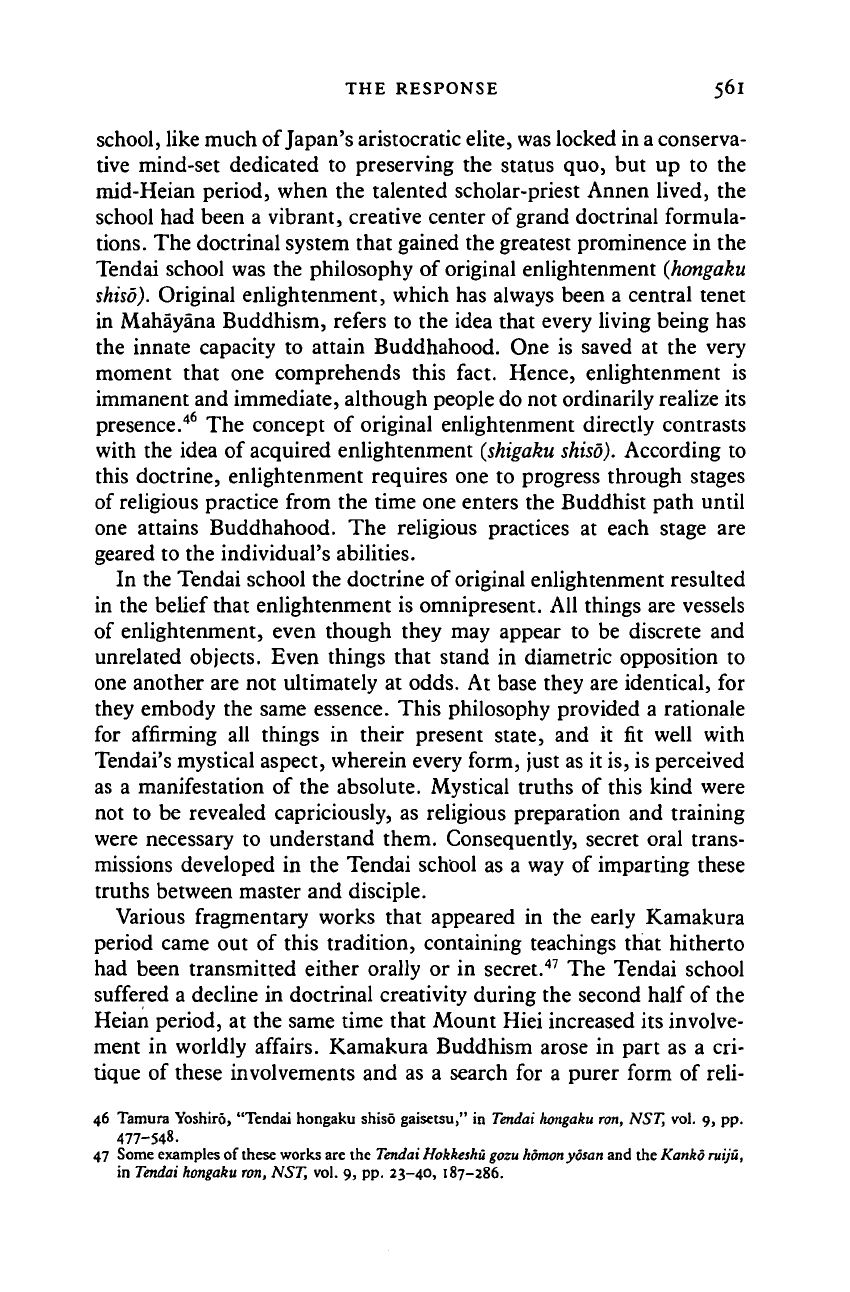
THE RESPONSE 561
school, like much of Japan's aristocratic
elite,
was locked in
a
conserva-
tive mind-set dedicated to preserving the status quo, but up to the
mid-Heian period, when the talented scholar-priest Annen lived, the
school had been a vibrant, creative center of grand doctrinal formula-
tions.
The doctrinal system that gained the greatest prominence in the
Tendai school was the philosophy of original enlightenment
(hongaku
shiso).
Original enlightenment, which has always been a central tenet
in Mahayana Buddhism, refers to the idea that every living being has
the innate capacity to attain Buddhahood. One is saved at the very
moment that one comprehends this fact. Hence, enlightenment is
immanent and immediate, although people do not ordinarily realize its
presence.
46
The concept of original enlightenment directly contrasts
with the idea of acquired enlightenment
(shigaku
shiso).
According to
this doctrine, enlightenment requires one to progress through stages
of religious practice from the time one enters the Buddhist path until
one attains Buddhahood. The religious practices at each stage are
geared to the individual's abilities.
In the Tendai school the doctrine of original enlightenment resulted
in the belief that enlightenment is omnipresent. All things are vessels
of enlightenment, even though they may appear to be discrete and
unrelated objects. Even things that stand in diametric opposition to
one another are not ultimately at odds. At base they are identical, for
they embody the same essence. This philosophy provided a rationale
for affirming all things in their present state, and it fit well with
Tendai's mystical aspect, wherein every form, just as it is, is perceived
as a manifestation of the absolute. Mystical truths of this kind were
not to be revealed capriciously, as religious preparation and training
were necessary to understand them. Consequently, secret oral trans-
missions developed in the Tendai school as a way of imparting these
truths between master and disciple.
Various fragmentary works that appeared in the early Kamakura
period came out of this tradition, containing teachings that hitherto
had been transmitted either orally or in secret.
47
The Tendai school
suffered a decline in doctrinal creativity during the second half of the
Heian period, at the same time that Mount Hiei increased its involve-
ment in worldly affairs. Kamakura Buddhism arose in part as a cri-
tique of these involvements and as a search for a purer form of reli-
46 Tamura Yoshiro, "Tendai hongaku shiso gaisetsu," in
Tendai hongaku
ron, NST, vol. 9, pp.
477-548.
47 Some examples of these works are the
Tendai Hokkeshu gozu
homon yosan and the Kanko ruiju,
in
Tendai hongaku
ron,
NST, vol. 9, pp. 23-40, 187-286.
Cambridge Histories Online © Cambridge University Press, 2008
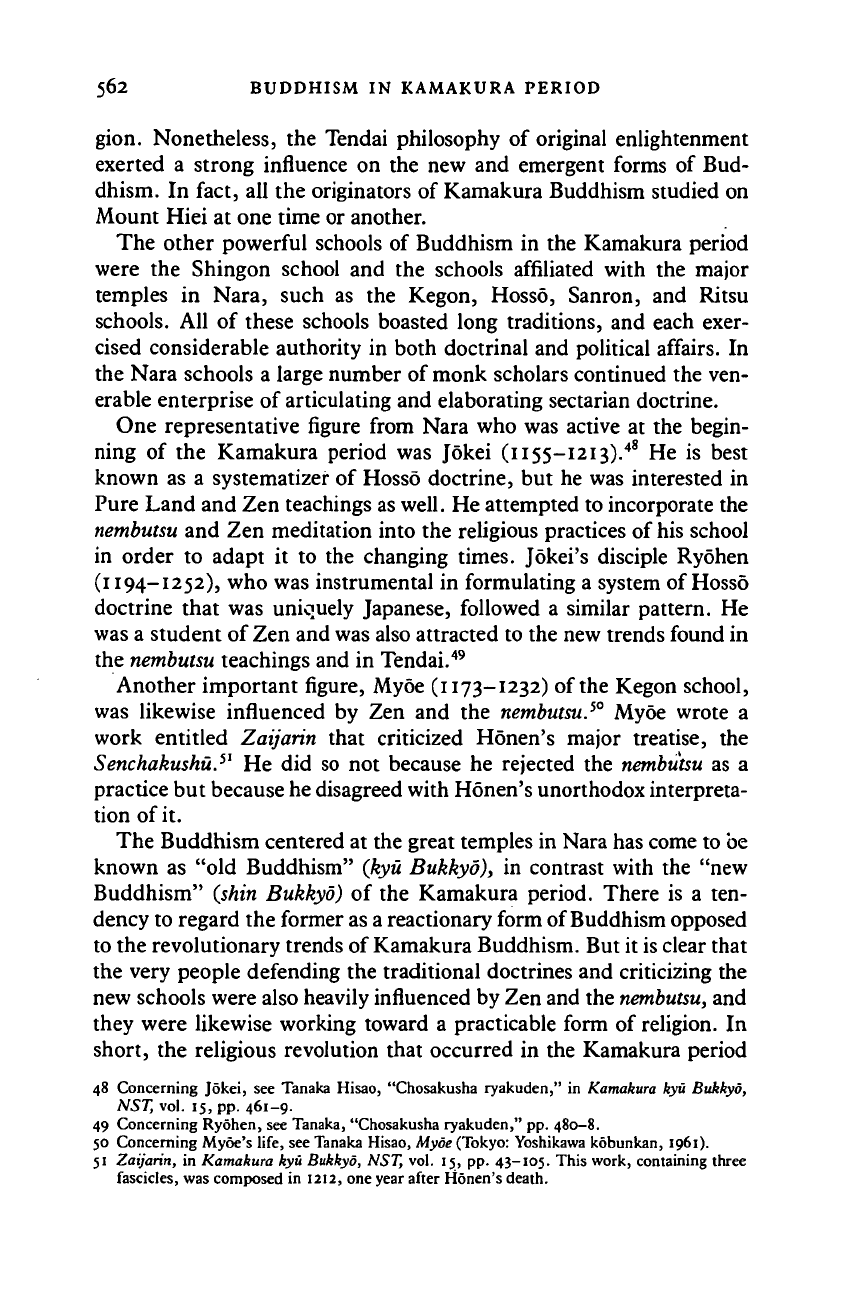
562 BUDDHISM IN KAMAKURA PERIOD
gion. Nonetheless, the Tendai philosophy of original enlightenment
exerted a strong influence on the new and emergent forms of Bud-
dhism. In fact, all the originators of Kamakura Buddhism studied on
Mount Hiei at one time or another.
The other powerful schools of Buddhism in the Kamakura period
were the Shingon school and the schools affiliated with the major
temples in Nara, such as the Kegon, Hosso, Sanron, and Ritsu
schools. All of these schools boasted long traditions, and each exer-
cised considerable authority in both doctrinal and political affairs. In
the Nara schools a large number of monk scholars continued the ven-
erable enterprise of articulating and elaborating sectarian doctrine.
One representative figure from Nara who was active at the begin-
ning of the Kamakura period was Jokei (1155-1213).
48
He is best
known as a systematizer of Hosso doctrine, but he was interested in
Pure Land and Zen teachings as well. He attempted to incorporate the
nembutsu
and Zen meditation into the religious practices of his school
in order to adapt it to the changing times. Jokei's disciple Ryohen
(1194-1252), who was instrumental in formulating a system of Hosso
doctrine that was uniquely Japanese, followed a similar pattern. He
was a student of Zen and was also attracted to the new trends found in
the
nembutsu
teachings and in Tendai.
49
Another important figure, Myoe (1173-1232) of the Kegon school,
was likewise influenced by Zen and the
nembutsu.
50
Myoe wrote a
work entitled Zaijarin that criticized Honen's major treatise, the
Senchakushii.
5
' He did so not because he rejected the
nembutsu
as a
practice but because he disagreed with Honen's unorthodox interpreta-
tion of it.
The Buddhism centered at the great temples in Nara has come to be
known as "old Buddhism" (kyu Bukkyd), in contrast with the "new
Buddhism" (shin Bukkyd) of the Kamakura period. There is a ten-
dency to regard the former as
a
reactionary form of Buddhism opposed
to the revolutionary trends of Kamakura Buddhism. But it is clear that
the very people defending the traditional doctrines and criticizing the
new schools were also heavily influenced by Zen and the
nembutsu,
and
they were likewise working toward a practicable form of religion. In
short, the religious revolution that occurred in the Kamakura period
48 Concerning Jokei, see Tanaka Hisao, "Chosakusha ryakuden," in Kamakura kyu Bukkyd,
NST, vol. 15, pp. 461-9.
49 Concerning Ryohen, see Tanaka, "Chosakusha ryakuden," pp. 480-8.
50 Concerning Myoe's life, see Tanaka Hisao, Myoe (Tokyo: Yoshikawa kobunkan, 1961).
51 Zaijarin, in Kamakura kyu Bukkyd, NST, vol. 15, pp. 43-105. This work, containing three
fascicles, was composed in 1212, one year after Honen's death.
Cambridge Histories Online © Cambridge University Press, 2008
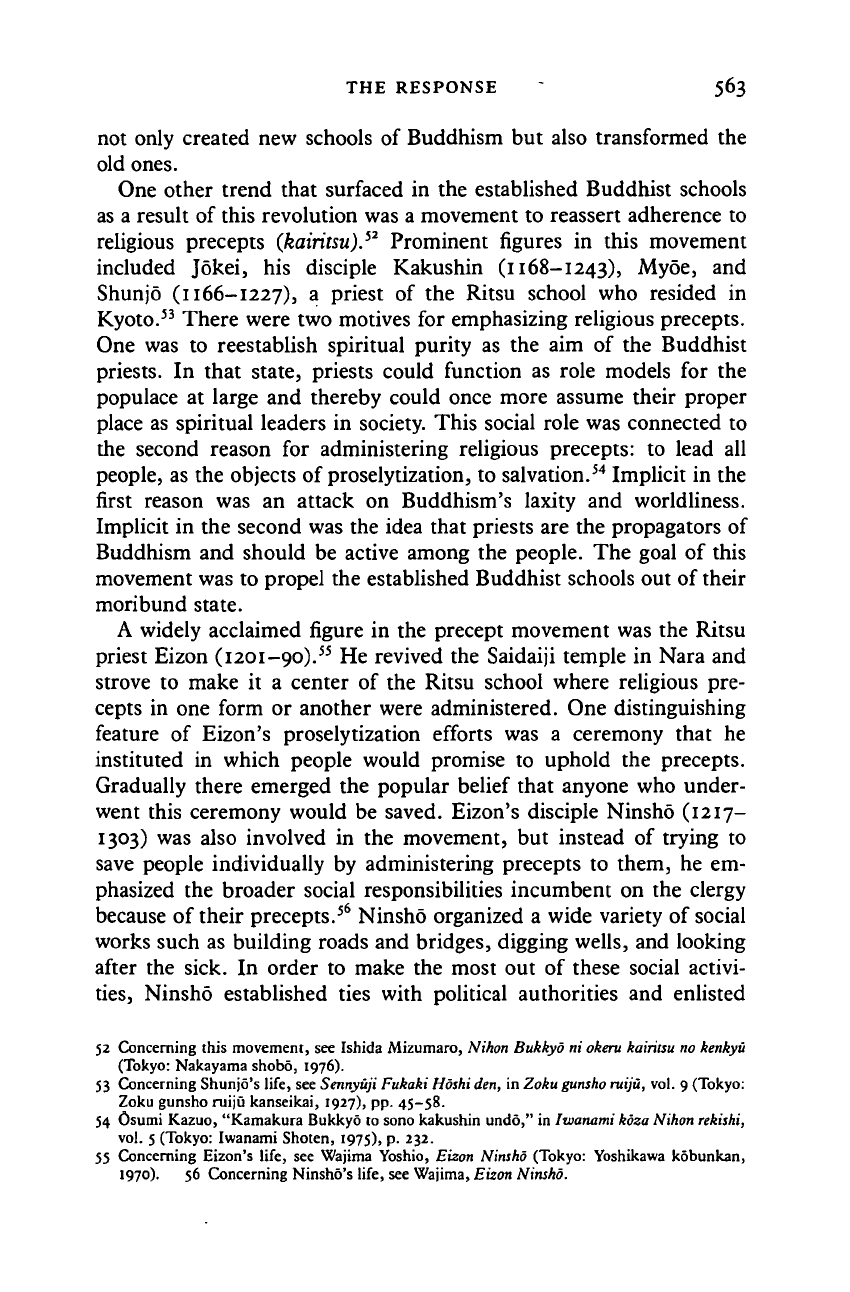
THE RESPONSE - 563
not only created new schools of Buddhism but also transformed the
old ones.
One other trend that surfaced in the established Buddhist schools
as a result of this revolution was a movement to reassert adherence to
religious precepts (kairitsu).
$2
Prominent figures in this movement
included Jokei, his disciple Kakushin (1168-1243), Myoe, and
Shunjo (1166-1227),
a
priest of the Ritsu school who resided in
Kyoto.
53
There were two motives for emphasizing religious precepts.
One was to reestablish spiritual purity as the aim of the Buddhist
priests. In that state, priests could function as role models for the
populace at large and thereby could once more assume their proper
place as spiritual leaders in society. This social role was connected to
the second reason for administering religious precepts: to lead all
people, as the objects of proselytization, to salvation.
54
Implicit in the
first reason was an attack on Buddhism's laxity and worldliness.
Implicit in the second was the idea that priests are the propagators of
Buddhism and should be active among the people. The goal of this
movement was to propel the established Buddhist schools out of their
moribund state.
A widely acclaimed figure in the precept movement was the Ritsu
priest Eizon (1201-90).
55
He revived the Saidaiji temple in Nara and
strove to make it a center of the Ritsu school where religious pre-
cepts in one form or another were administered. One distinguishing
feature of Eizon's proselytization efforts was a ceremony that he
instituted in which people would promise to uphold the precepts.
Gradually there emerged the popular belief that anyone who under-
went this ceremony would be saved. Eizon's disciple Ninsho (1217-
1303) was also involved in the movement, but instead of trying to
save people individually by administering precepts to them, he em-
phasized the broader social responsibilities incumbent on the clergy
because of their precepts.
56
Ninsho organized a wide variety of social
works such as building roads and bridges, digging wells, and looking
after the sick. In order to make the most out of these social activi-
ties,
Ninsho established ties with political authorities and enlisted
52 Concerning this movement, see Ishida Mizumaro, Nihon Bukkyo ni okeru kainisu no kenkyu
(Tokyo: Nakayama shobo, 1976).
53 Concerning Shunjo's life, see Sennyitji Fukaki Hoshi den, in Zoku gunsho ruiju, vol. 9 (Tokyo:
Zoku gunsho ruiju kanseikai, 1927), pp. 45-58.
54 Osumi Kazuo, "Kamakura Bukkyo to sono kakushin undo," in Iwanami koza Nihon rekishi,
vol.
5 (Tokyo: Iwanami Shoten, 1975), p. 232.
55 Concerning Eizon's life, see Wajima Yoshio, Eizon Ninsho (Tokyo: Yoshikawa kobunkan,
1970).
56 Concerning Ninsho's life, see Wajima, Eizon Ninsho.
Cambridge Histories Online © Cambridge University Press, 2008
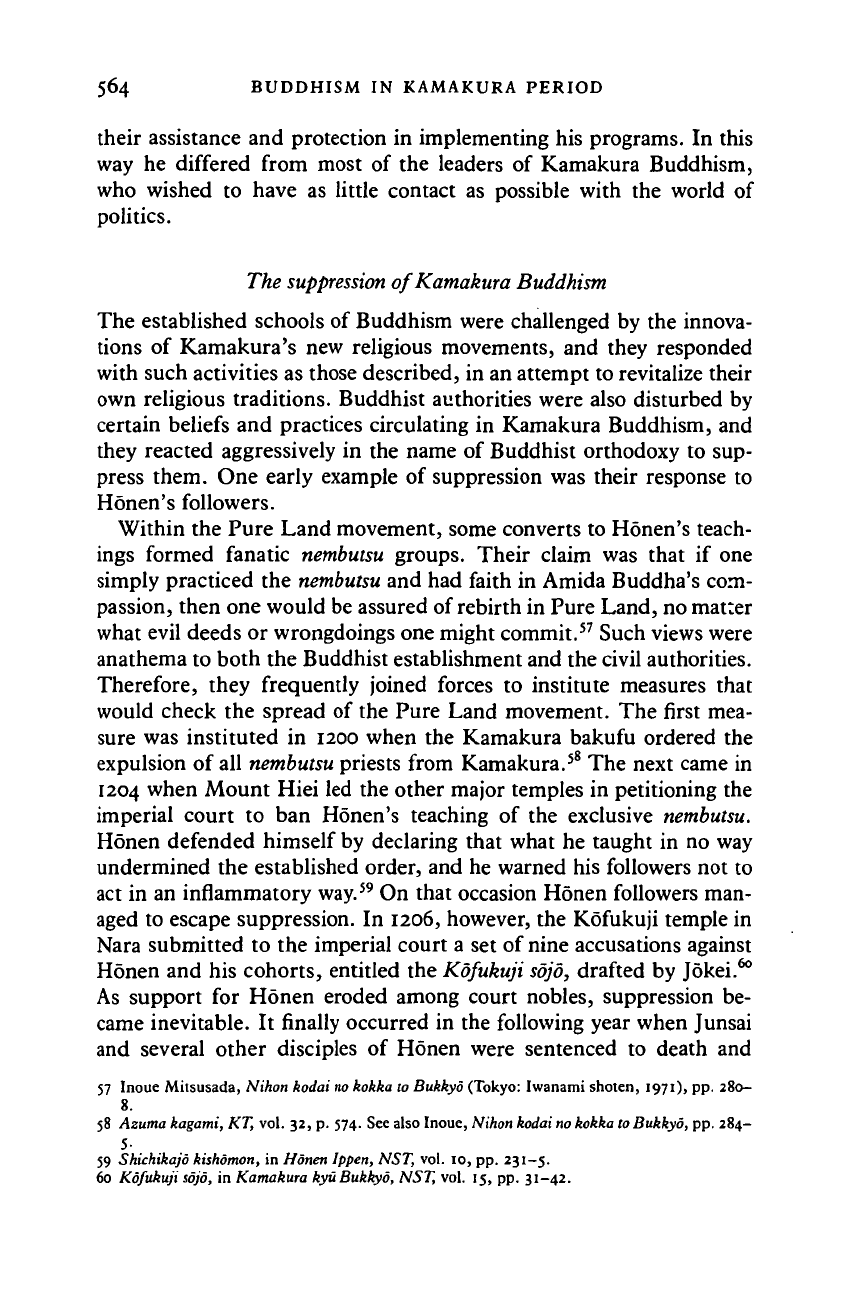
564 BUDDHISM IN KAMAKURA PERIOD
their assistance and protection in implementing his programs. In this
way he differed from most of the leaders of Kamakura Buddhism,
who wished to have as little contact as possible with the world of
politics.
The
suppression
of Kamakura Buddhism
The established schools of Buddhism were challenged by the innova-
tions of Kamakura's new religious movements, and they responded
with such activities as those described, in an attempt to revitalize their
own religious traditions. Buddhist authorities were also disturbed by
certain beliefs and practices circulating in Kamakura Buddhism, and
they reacted aggressively in the name of Buddhist orthodoxy to sup-
press them. One early example of suppression was their response to
Honen's followers.
Within the Pure Land movement, some converts to Honen's teach-
ings formed fanatic
nembutsu
groups. Their claim was that if one
simply practiced the
nembutsu
and had faith in Amida Buddha's com-
passion, then one would be assured of rebirth in Pure Land, no matter
what evil deeds or wrongdoings one might commit.
57
Such views were
anathema to both the Buddhist establishment and the civil authorities.
Therefore, they frequently joined forces to institute measures that
would check the spread of the Pure Land movement. The first mea-
sure was instituted in 1200 when the Kamakura bakufu ordered the
expulsion of all
nembutsu
priests from Kamakura.
58
The next came in
1204 when Mount Hiei led the other major temples in petitioning the
imperial court to ban Honen's teaching of the exclusive
nembutsu.
Honen defended himself by declaring that what he taught in no way
undermined the established order, and he warned his followers not to
act in an inflammatory way.
59
On that occasion Honen followers man-
aged to escape suppression. In 1206, however, the Kofukuji temple in
Nara submitted to the imperial court a set of nine accusations against
Honen and his cohorts, entitled the Kofukuji
sojo,
drafted by Jokei.
60
As support for Honen eroded among court nobles, suppression be-
came inevitable. It finally occurred in the following year when Junsai
and several other disciples of Honen were sentenced to death and
57 Inoue Mitsusada, Nihon kodai
no
kokka to Bukkyo (Tokyo: Iwanami shoten, 1971)) pp. 280-
8.
58 Azuma kagami, KT, vol. 32, p. 574. See also Inoue, Nihon kodai no kokka
to
Bukkyo, pp. 284-
5-
59 Shichikajo kishomon, in Honen Ippen, NST, vol. 10, pp. 231-5.
60 Kofukuji
sojo,
in Kamakura kyu Bukkyo, NST, vol. 15, pp. 31-42.
Cambridge Histories Online © Cambridge University Press, 2008
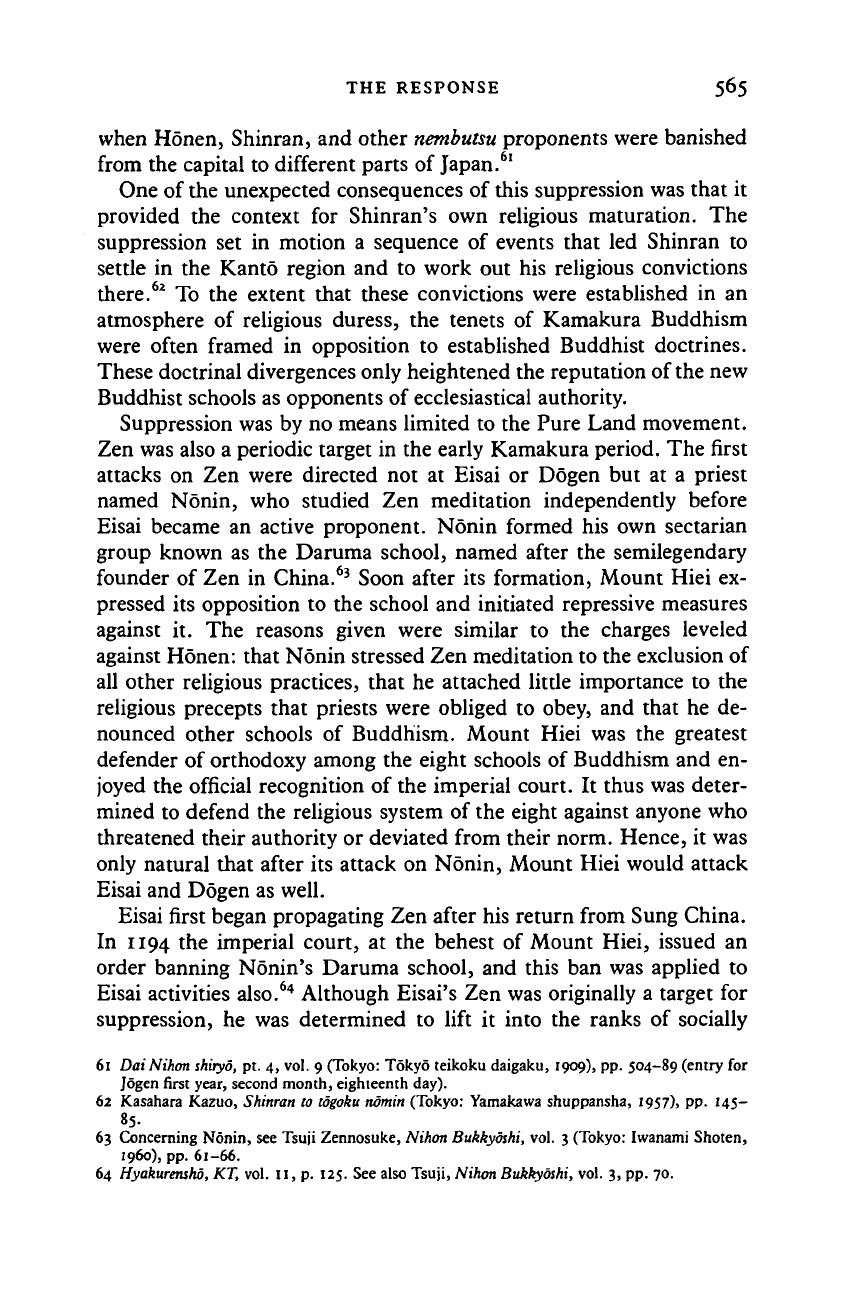
THE RESPONSE 565
when Honen, Shinran, and other
nembutsu
proponents were banished
from the capital to different parts of Japan.
6
'
One of the unexpected consequences of this suppression was that it
provided the context for Shinran's own religious maturation. The
suppression set in motion a sequence of events that led Shinran to
settle in the Kanto region and to work out his religious convictions
there.
62
To the extent that these convictions were established in an
atmosphere of religious duress, the tenets of Kamakura Buddhism
were often framed in opposition to established Buddhist doctrines.
These doctrinal divergences only heightened the reputation of
the
new
Buddhist schools as opponents of ecclesiastical authority.
Suppression was by no means limited to the Pure Land movement.
Zen was also a periodic target in the early Kamakura period. The first
attacks on Zen were directed not at Eisai or Dogen but at a priest
named Nonin, who studied Zen meditation independently before
Eisai became an active proponent. Nonin formed his own sectarian
group known as the Daruma school, named after the semilegendary
founder of Zen in China.
63
Soon after its formation, Mount Hiei ex-
pressed its opposition to the school and initiated repressive measures
against it. The reasons given were similar to the charges leveled
against Honen: that Nonin stressed Zen meditation to the exclusion of
all other religious practices, that he attached little importance to the
religious precepts that priests were obliged to obey, and that he de-
nounced other schools of Buddhism. Mount Hiei was the greatest
defender of orthodoxy among the eight schools of Buddhism and en-
joyed the official recognition of the imperial court. It thus was deter-
mined to defend the religious system of the eight against anyone who
threatened their authority or deviated from their norm. Hence, it was
only natural that after its attack on Ndnin, Mount Hiei would attack
Eisai and Dogen as well.
Eisai first began propagating Zen after his return from Sung China.
In 1194 the imperial court, at the behest of Mount Hiei, issued an
order banning Nonin's Daruma school, and this ban was applied to
Eisai activities also.
64
Although Eisai's Zen was originally a target for
suppression, he was determined to lift it into the ranks of socially
61 DaiNihon shiryo, pt. 4, vol. 9 (Tokyo: Tokyo teikoku daigaku, 1909), pp. 504-89 (entry for
Jogen first year, second month, eighteenth day).
62 Kasahara Kazuo, Shinran to
togoku nomin
(Tokyo: Yamakawa shuppansha, 1957), pp. 145-
85.
63 Concerning Nonin, see Tsuji Zennosuke, Nihon Bukkyoshi, vol. 3 (Tokyo: Iwanami Shoten,
i960),
pp. 61-66.
64
Hyakurensho,
KT, vol. 11, p. 125. See also Tsuji, Nihon Bukkyoshi, vol. 3, pp. 70.
Cambridge Histories Online © Cambridge University Press, 2008
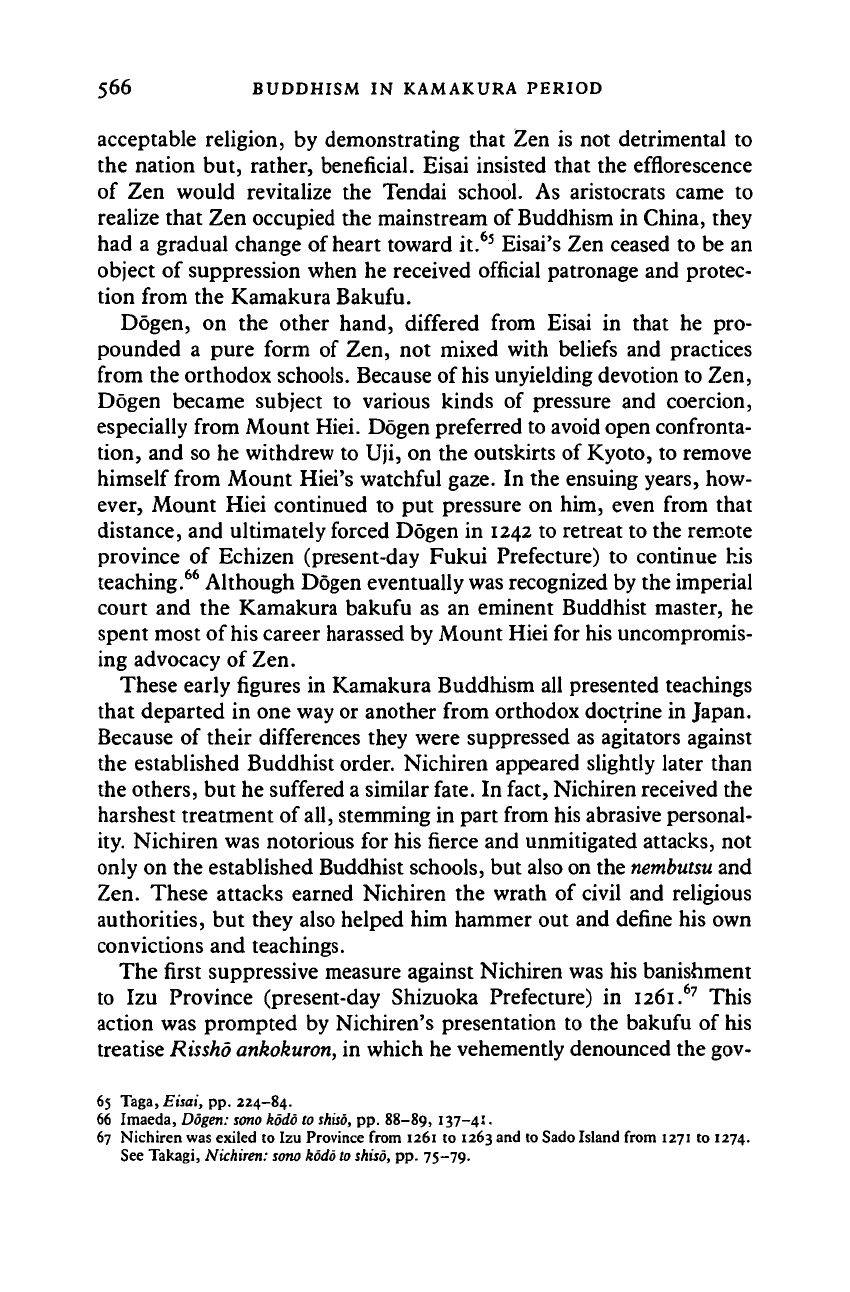
566 BUDDHISM IN KAMAKURA PERIOD
acceptable religion, by demonstrating that Zen is not detrimental to
the nation but, rather, beneficial. Eisai insisted that the efflorescence
of Zen would revitalize the Tendai school. As aristocrats came to
realize that Zen occupied the mainstream of Buddhism in China, they
had a gradual change of heart toward it.
65
Eisai's Zen ceased to be an
object of suppression when he received official patronage and protec-
tion from the Kamakura Bakufu.
Dogen, on the other hand, differed from Eisai in that he pro-
pounded a pure form of Zen, not mixed with beliefs and practices
from the orthodox schools. Because of
his
unyielding devotion to Zen,
Dogen became subject to various kinds of pressure and coercion,
especially from Mount Hiei. Dogen preferred to avoid open confronta-
tion, and so he withdrew to Uji, on the outskirts of Kyoto, to remove
himself from Mount Hiei's watchful gaze. In the ensuing years, how-
ever, Mount Hiei continued to put pressure on him, even from that
distance, and ultimately forced Dogen in 1242 to retreat to the remote
province of Echizen (present-day Fukui Prefecture) to continue his
teaching.
66
Although Dogen eventually was recognized by the imperial
court and the Kamakura bakufu as an eminent Buddhist master, he
spent most of
his
career harassed by Mount Hiei for his uncompromis-
ing advocacy of Zen.
These early figures in Kamakura Buddhism all presented teachings
that departed in one way or another from orthodox doctrine in Japan.
Because of their differences they were suppressed as agitators against
the established Buddhist order. Nichiren appeared slightly later than
the others, but he suffered a similar fate. In fact, Nichiren received the
harshest treatment of
all,
stemming in part from his abrasive personal-
ity. Nichiren was notorious for his fierce and unmitigated attacks, not
only on the established Buddhist schools, but also on the
nembutsu
and
Zen. These attacks earned Nichiren the wrath of civil and religious
authorities, but they also helped him hammer out and define his own
convictions and teachings.
The first suppressive measure against Nichiren was his banishment
to Izu Province (present-day Shizuoka Prefecture) in
1261.
67
This
action was prompted by Nichiren's presentation to the bakufu of his
treatise
Rissho
ankokuron,
in which he vehemently denounced the gov-
65 Taga, Eisai, pp. 224-84.
66 Imaeda, Dogen:
sono
kodo to
shiso,
pp. 88-89, I37-4
1
-
67 Nichiren was exited to Izu Province from 1261 to 1263 and to Sado Island from 1271 to 1274.
See Takagi, Nichiren:
sono kodo to
shiso,
pp. 75-79.
Cambridge Histories Online © Cambridge University Press, 2008
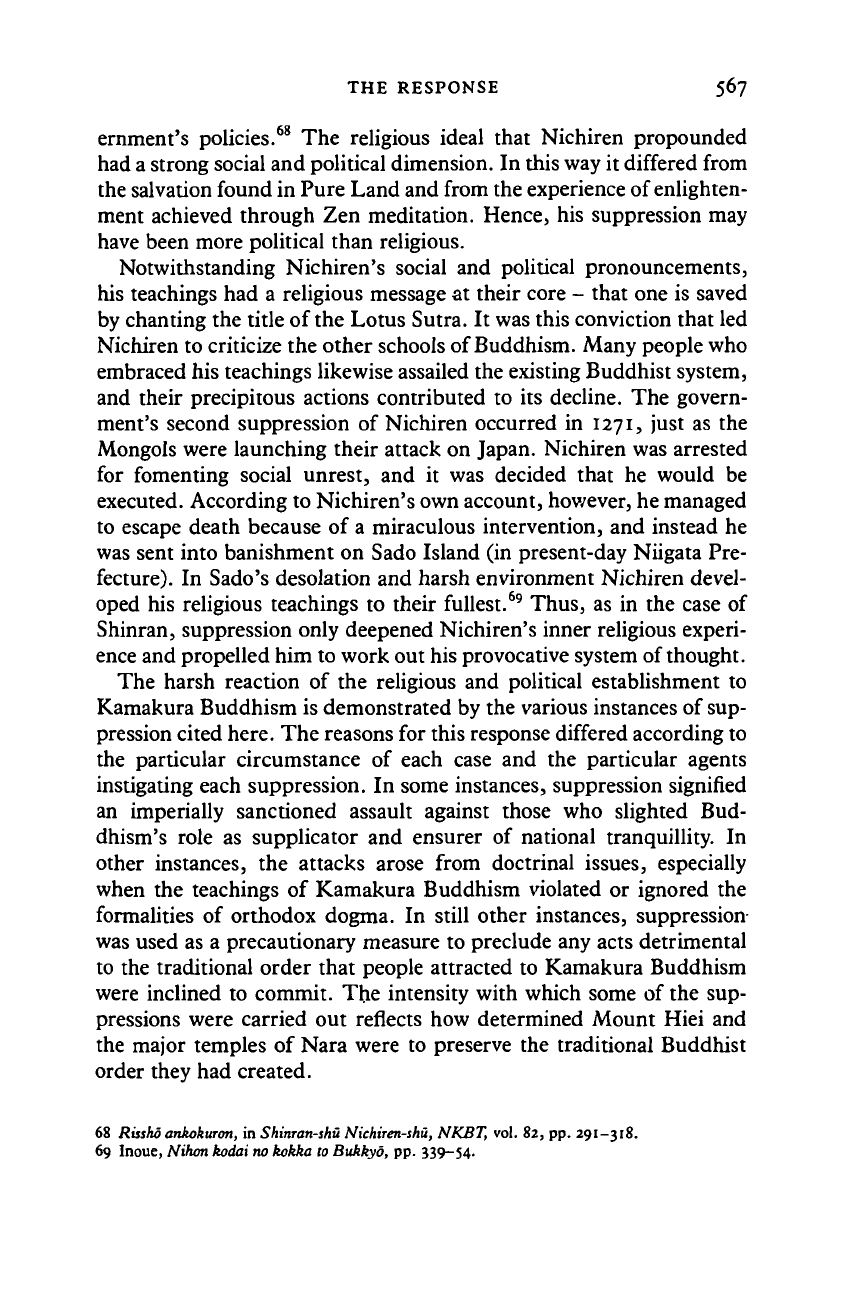
THE RESPONSE 567
ernment's policies.
68
The religious ideal that Nichiren propounded
had
a
strong social and political dimension. In this way it differed from
the salvation found in Pure Land and from the experience of enlighten-
ment achieved through Zen meditation. Hence, his suppression may
have been more political than religious.
Notwithstanding Nichiren's social and political pronouncements,
his teachings had a religious message at their core - that one is saved
by chanting the title of the Lotus Sutra. It was this conviction that led
Nichiren to criticize the other schools of Buddhism. Many people who
embraced his teachings likewise assailed the existing Buddhist system,
and their precipitous actions contributed to its decline. The govern-
ment's second suppression of Nichiren occurred in 1271, just as the
Mongols were launching their attack on Japan. Nichiren was arrested
for fomenting social unrest, and it was decided that he would be
executed. According to Nichiren's own account, however, he managed
to escape death because of a miraculous intervention, and instead he
was sent into banishment on Sado Island (in present-day Niigata Pre-
fecture). In Sado's desolation and harsh environment Nichiren devel-
oped his religious teachings to their fullest.
69
Thus, as in the case of
Shinran, suppression only deepened Nichiren's inner religious experi-
ence and propelled him to work out his provocative system of thought.
The harsh reaction of the religious and political establishment to
Kamakura Buddhism is demonstrated by the various instances of sup-
pression cited here. The reasons for this response differed according to
the particular circumstance of each case and the particular agents
instigating each suppression. In some instances, suppression signified
an imperially sanctioned assault against those who slighted Bud-
dhism's role as supplicator and ensurer of national tranquillity. In
other instances, the attacks arose from doctrinal issues, especially
when the teachings of Kamakura Buddhism violated or ignored the
formalities of orthodox dogma. In still other instances, suppression-
was used as a precautionary measure to preclude any acts detrimental
to the traditional order that people attracted to Kamakura Buddhism
were inclined to commit. The intensity with which some of the sup-
pressions were carried out reflects how determined Mount Hiei and
the major temples of Nara were to preserve the traditional Buddhist
order they had created.
68 Rissho
ankokuron,
in
Shinran-shu
Nichiren-shu,
NKBT,
vol. 82, pp. 291-318.
69 Inoue, Nihon kodai no kokka to Bukkyo, pp. 339-54.
Cambridge Histories Online © Cambridge University Press, 2008
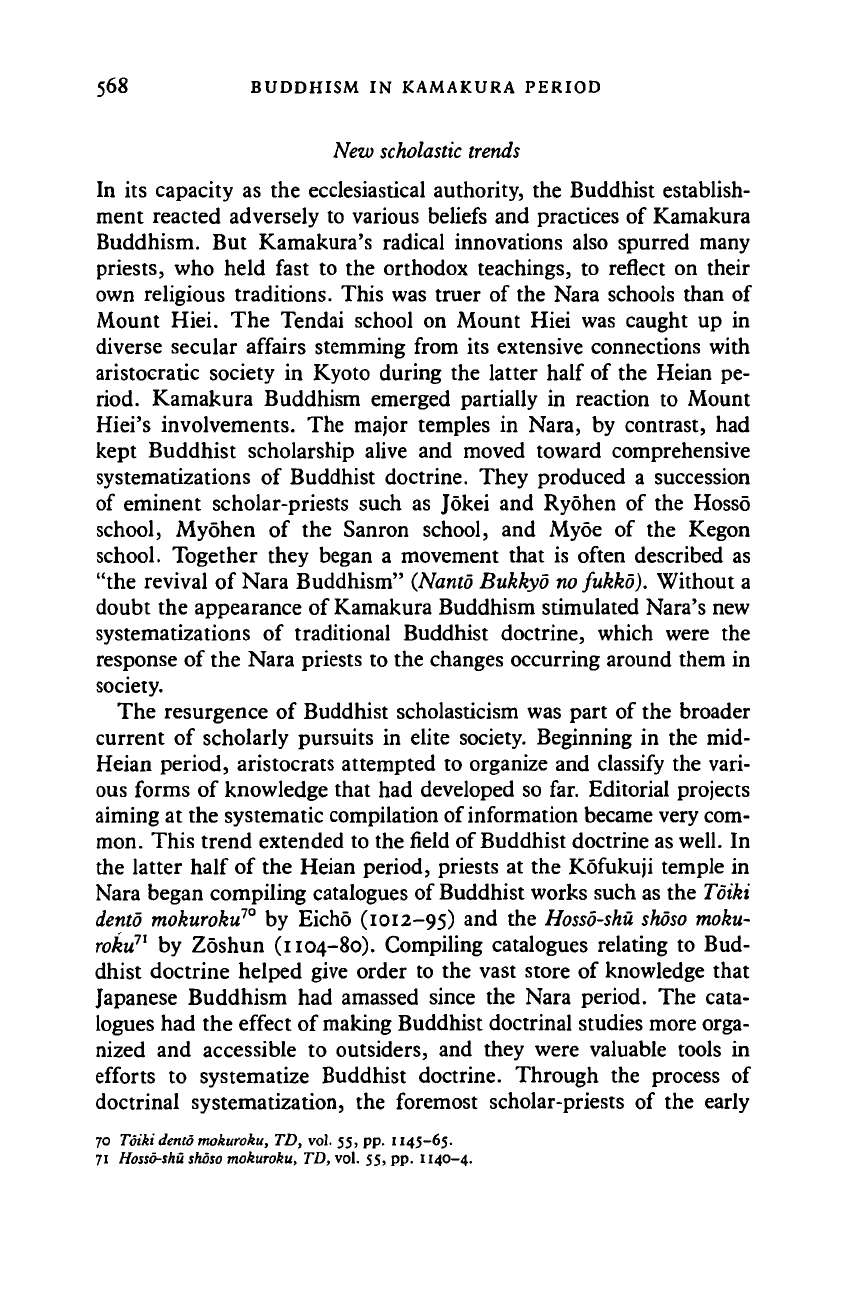
568 BUDDHISM IN KAMAKURA PERIOD
New scholastic trends
In its capacity as the ecclesiastical authority, the Buddhist establish-
ment reacted adversely to various beliefs and practices of Kamakura
Buddhism. But Kamakura's radical innovations also spurred many
priests, who held fast to the orthodox teachings, to reflect on their
own religious traditions. This was truer of the Nara schools than of
Mount Hiei. The Tendai school on Mount Hiei was caught up in
diverse secular affairs stemming from its extensive connections with
aristocratic society in Kyoto during the latter half of the Heian pe-
riod. Kamakura Buddhism emerged partially in reaction to Mount
Hiei's involvements. The major temples in Nara, by contrast, had
kept Buddhist scholarship alive and moved toward comprehensive
systematizations of Buddhist doctrine. They produced a succession
of eminent scholar-priests such as Jokei and Ryohen of the Hosso
school, Myohen of the Sanron school, and Myoe of the Kegon
school. Together they began a movement that is often described as
"the revival of Nara Buddhism"
(Nanto
Bukkyo
no
fukko). Without a
doubt the appearance of Kamakura Buddhism stimulated Nara's new
systematizations of traditional Buddhist doctrine, which were the
response of the Nara priests to the changes occurring around them in
society.
The resurgence of Buddhist scholasticism was part of the broader
current of scholarly pursuits in elite society. Beginning in the mid-
Heian period, aristocrats attempted to organize and classify the vari-
ous forms of knowledge that had developed so far. Editorial projects
aiming at the systematic compilation of information became very com-
mon. This trend extended to the field of Buddhist doctrine as well. In
the latter half of the Heian period, priests at the Kofukuji temple in
Nara began compiling catalogues of Buddhist works such as the Toiki
dento mokuroku
70
by Eicho (1012-95)
a
°d the Hosso-shu shoso moku-
roku
71
by Zoshun (1104-80). Compiling catalogues relating to Bud-
dhist doctrine helped give order to the vast store of knowledge that
Japanese Buddhism had amassed since the Nara period. The cata-
logues had the effect of making Buddhist doctrinal studies more orga-
nized and accessible to outsiders, and they were valuable tools in
efforts to systematize Buddhist doctrine. Through the process of
doctrinal systematization, the foremost scholar-priests of the early
70 Toiki dento mokuroku, TD, vol. 55, pp. 1145-65.
71
Hosso-shu shoso
mokuroku, TD, vol. 55, pp. 1140-4.
Cambridge Histories Online © Cambridge University Press, 2008
